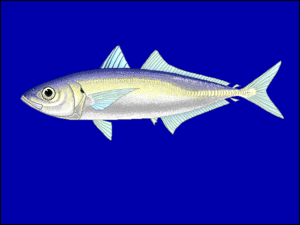Decapterus russelli facts for kids
Quick facts for kids Decapterus russelli |
|
|---|---|
 |
|
| Conservation status | |
| Scientific classification | |
| Synonyms | |
|
The Indian Scad (scientific name: Decapterus russelli) is a type of fish. It is also called the Northern mackerel scad, round scad, or slender scad. This fish belongs to the Decapterus group and the Carangidae family. You can find it mainly in the Indian Ocean.
This fish has also moved into the eastern Mediterranean Sea. It got there by swimming through the Suez Canal. The Indian Scad is a very important fish for people who fish along the coasts where it lives.
Contents
What Does the Indian Scad Look Like?
The Indian Scad has a long, somewhat thin body. Its body is also a bit flat from side to side. Its eyes are medium-sized and have a special eyelid that covers most of the eye.
The scales on its head do not reach the middle of its eyes. It has a special line on its side called a lateral line. This line helps the fish sense movement in the water.
Fins and Color
The Indian Scad has two dorsal fins (on its back). The first dorsal fin is shaped like a triangle and has 8 stiff spines. The second dorsal fin has one spine and many soft rays.
Its anal fin (on its belly, near the tail) has 2 separate spines. It also has one spine and many soft rays. The last rays of its dorsal and anal fins are like small, separate fins. Its pectoral fins (on its sides) are quite long.
When alive, the Indian Scad is bluish-green on top. Its belly is shiny and silver. It has a small black spot near the top edge of its gill cover. Its tail fin can be clear or dark brown. Other fins are mostly clear. Adult male pelvic fins (bottom fins) can be a bit darker.
Size and Weight
The Indian Scad can grow up to 45 centimeters (about 18 inches) long. Most of them are around 30 centimeters (about 12 inches) long. The heaviest Indian Scad ever recorded weighed about 110 grams (about 0.24 pounds).
Where Does the Indian Scad Live?
You can find the Decapterus russelli all over the Indian Ocean. This includes the coasts of eastern Africa, from the Gulf of Suez down to South Africa. It also lives eastwards into the western Pacific Ocean. This area stretches from Japan in the north down to Australia.
Moving to New Waters
The Indian Scad is a "Lessepsian migrant". This means it moved from the Red Sea into the eastern Mediterranean Sea. It traveled through the Suez Canal. Scientists first saw it near Israel in 2005. Now, it is common as far north as southeastern Turkey. It has become an important fish for local fishing in these new areas.
What the Indian Scad Eats and How it Lives
Adult Indian Scads usually live near the bottom of the ocean. They form very large groups called schools in deeper waters. Sometimes, you might find smaller groups closer to shore in calm bays. This fish is the most common type of Decapterus in coastal waters. It also lives in open, shallow areas of the Indian Ocean.
What's on the Menu?
Indian Scads mostly eat small creatures that float in the water. These are called planktonic invertebrates. One study in India found that a small shrimp called Acetes indicus was their favorite food. This was true for both young and adult fish.
Bigger Indian Scads also hunt many different kinds of fish. These can include Lactarius lactarius, Leiognathus spp, lanternfishes, and eels. They also eat Nemipterus spp, Saurida tumbil, and Stolephorus spp.
Life Cycle
The Indian Scad can become a parent when it is about 1 year old. At this age, it is usually about 12 centimeters (about 4.7 inches) long. It can also be a host to a tiny creature called a copepod. This copepod, Lernanthropus decapteri, lives on the outside of the fish.
Fishing and How People Use the Indian Scad
People fish for the Indian Scad wherever it lives. They usually catch it using large nets called seine nets or by dragging nets along the bottom (trawls).
Catching and Selling
In 1999, people caught almost 160,000 tonnes of Indian Scad. The two main countries that caught this fish were Thailand and Malaysia. Thailand caught 82,000 tonnes, and Malaysia caught 70,160 tonnes.
Since the 1950s, the amount of Indian Scad caught has gone up and down. There isn't a clear pattern of it increasing or decreasing. However, in Southeast Asia, people are fishing much harder for it. Even with more effort, they are not catching more fish. This might mean that too many fish are being caught, and the fishery is "over-exploited."
The Indian Scad is often sold fresh. It can also be dried, salted, frozen, or put into cans.
Why is it Called the Indian Scad?
The scientific name russelli for this fish honors a Scottish surgeon and expert on reptiles named Patrick Russell. He lived from 1726 to 1805. Patrick Russell described and drew this fish in 1803. However, he did not give it a specific name himself.
Images for kids
See also
 In Spanish: Decapterus russelli para niños
In Spanish: Decapterus russelli para niños



